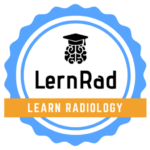Description
In this Go!Cards set, you will find a total of 50 questions and answers on the topic of Medical Imaging and Informatics for teaching radiological content in medical training. You can quickly review and test the most important facts before the exam to see where your knowledge stands.
 Our Go!Cards were developed according to the current Curriculum for Undergraduate Radiological Education of the European Society of Radiology (ESR).
Our Go!Cards were developed according to the current Curriculum for Undergraduate Radiological Education of the European Society of Radiology (ESR).
This set includes 50 questions and answers with the following subchapters:
- X-Ray – Radiation Physics
- X-Ray – X-Ray Radiation
- X-Ray – Important Dosage Terms
- X-Ray – X-Ray Equipment
- CT – Structure and Techniques
- CT – Image Formation
- CT – Image Quality
- Angiography
- MRI – Basics
- MRI – Structure and Technique
- MRI – Sequences
- Sonography – Fundamentals
- Sonography – Device and Technique
- Informatics
Tip: You should view the flashcards in full-screen mode, then they appear a bit larger. 🙂 We recommend using Chrome or Edge as a browser, as other browsers may display minor errors with the Go!Cards.
For the duration of your subscription (which will be automatically renewed each month if not canceled), you have full access to the Go!Cards. You can cancel your subscription at any time. Sharing your access data with third parties is, of course, not permitted (see also our general terms and conditions).
The specific learning objectives corresponding to the ESR’s Curriculum for Undergraduate Radiological Education are:
Module U-I-1 Principles of Radiation Biology and Radiation Protection
Knowledge
- To list the sources and properties of ionising radiation and radioactive decay
- To describe the generation of X-rays and their interaction with matter
- To describe the most important dose measures, including absorbed energy dose (Gy), organ and effective doses (Sv)
- To be familiar with the principles of the dose length product (DLP)
- To explain stochastic, deterministic and teratogenic radiation effects
- To describe the effects of ionising radiation on cells, tissues and organs and to list the mechanisms of repair
- To list types and magnitudes of radiation risk from radiation exposure in medicine and to compare it to radiation exposure from natural sources
- To list the factors influencing image quality and dose in diagnostic radiology
Module U-I-2 Principles of Radiological Techniques
Knowledge
- To describe the relative value of a radiographic examination for various organ systems and indications
- To list the components of an X-ray unit and explain the process of X-ray generation
- To describe the principles of fluoroscopy and its common indications
- To list and describe the factors affecting image quality and dose in radiography and fluoroscopy
- To describe the principles of soft tissue radiography in mammography
- To explain the concept of spatial, temporal and contrast resolution
- To explain the principle of contrast in the different imaging modalities
- To describe the relative diagnostic value of a computed tomography (CT) examination for the various organ systems and indications
- To explain the physical basis of image formation of computed tomography
- To describe the scale of Hounsfield units (HU) and the principle of window centre and width
- To list normal levels of attenuation (in HU) for various organs and common pathologies (e.g. haemorrhage, calcifications)
- To explain the relative value of a magnetic resonance imaging (MRI) examination for the various organ systems and indications
- To describe the basic principles of image formation with MRI
- To list the most commonly used pulse sequences in MRI (including T2-weighted sequences, T1-weighted sequences, fat suppressed sequences such as STIR sequences, FLAIR sequences, diffusion-weighted imaging)
- To describe the absolute or relative contraindications against MRI
- To explain the safety issues in the MR environment with regard to patients and staff
- To explain the relative value of an ultrasound examination for various organ systems and indications
- To describe the basic principles of image formation with ultrasonography and to list the tissue properties that determine it
- To be aware of the indications and contraindications for contrast-enhanced ultrasonography
- To describe the principles of the Doppler effect
- To describe the principles of digital subtraction angiography (DSA)
- To have a basic understanding of the different types and techniques of image-guided interventions
- To describe the basic infrastructure of imaging informatics, including Picture Archiving and Communication Systems (PACS) and Radiological Information Systems (RIS) and applications of Artificial Intelligence and Deep Learning to Radiology







Reviews
There are no reviews yet.